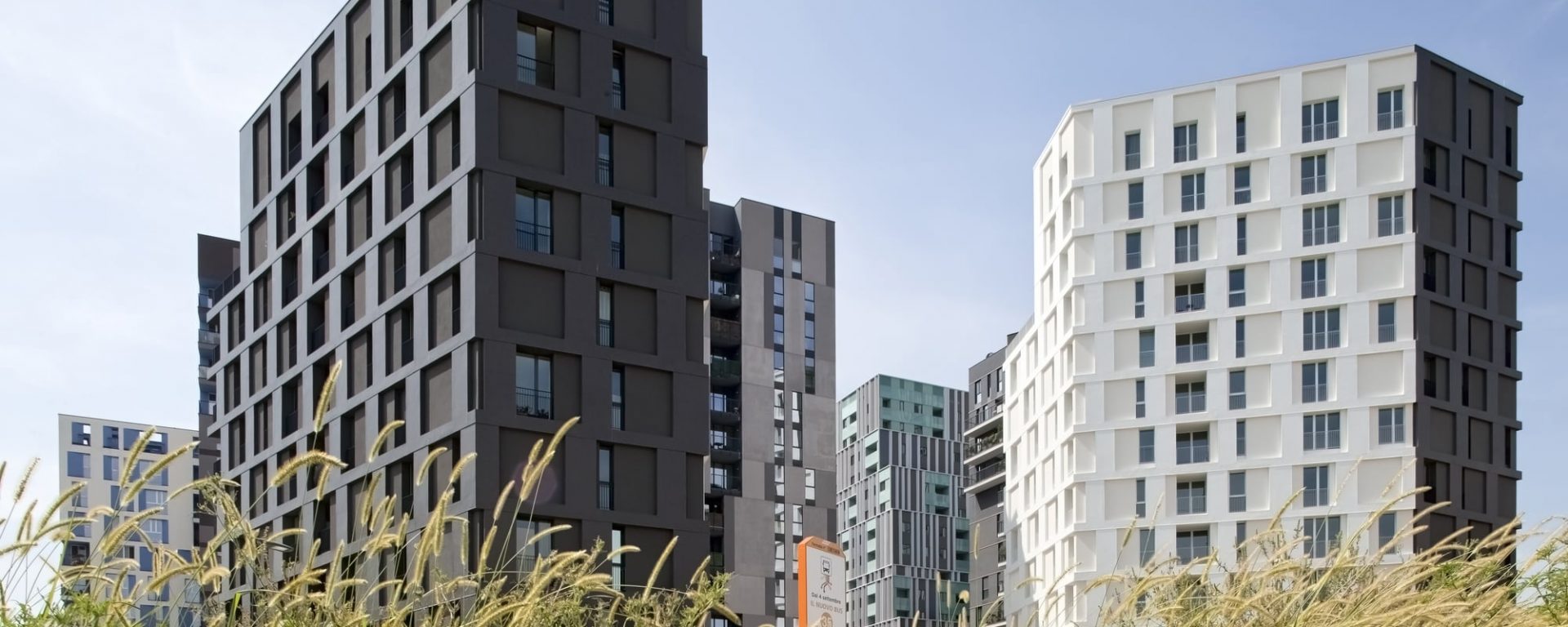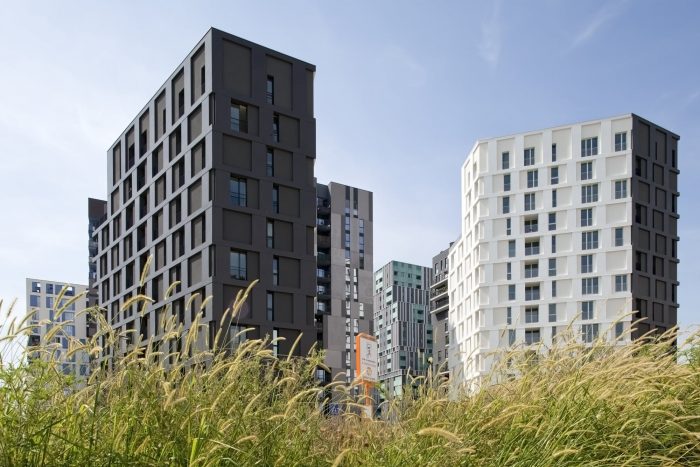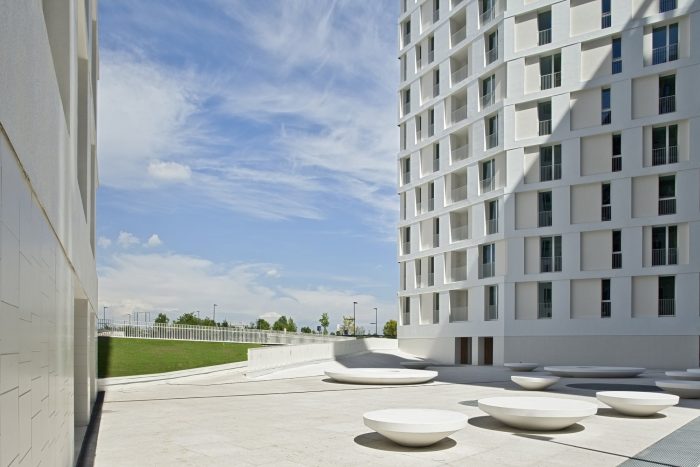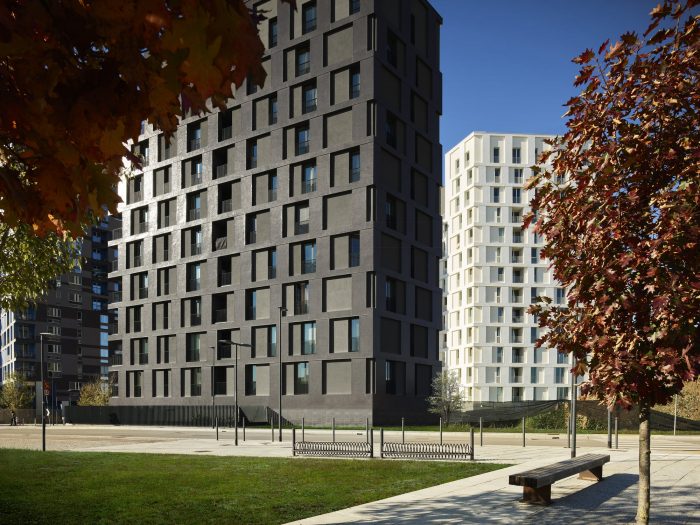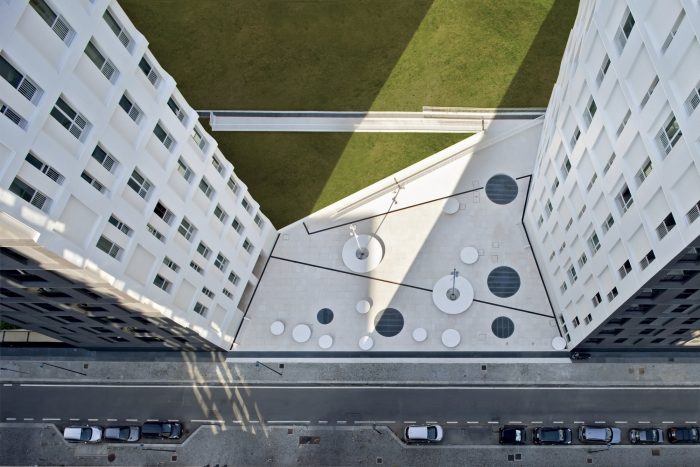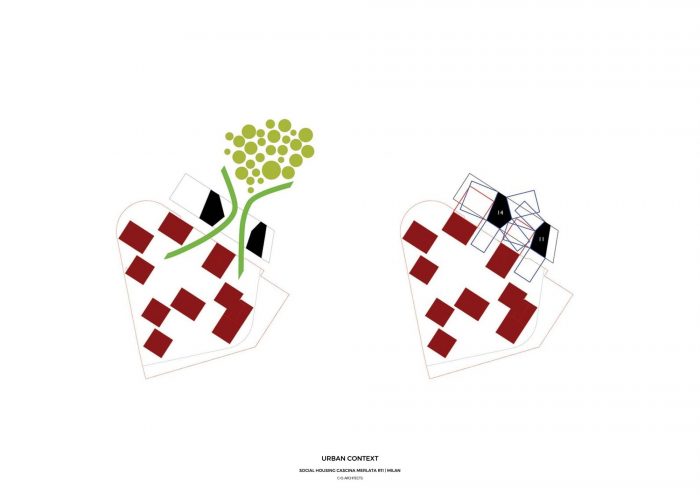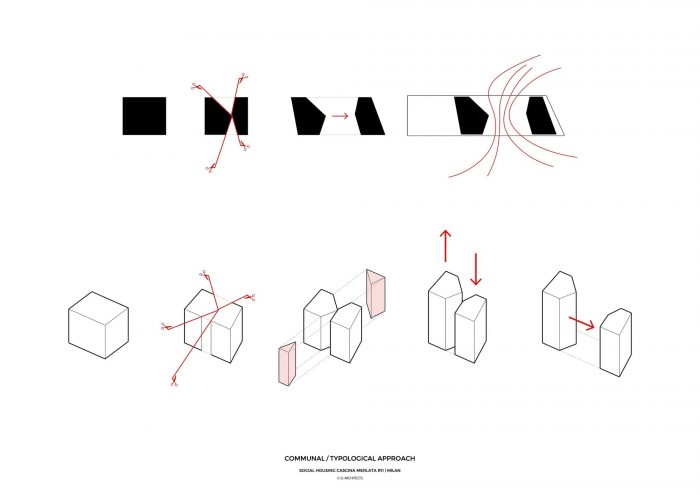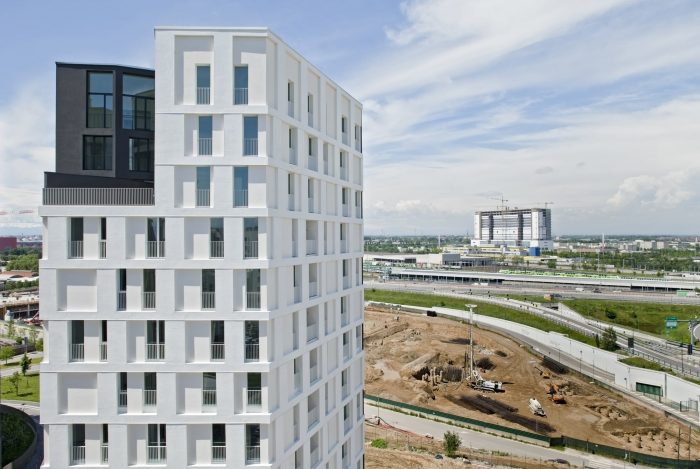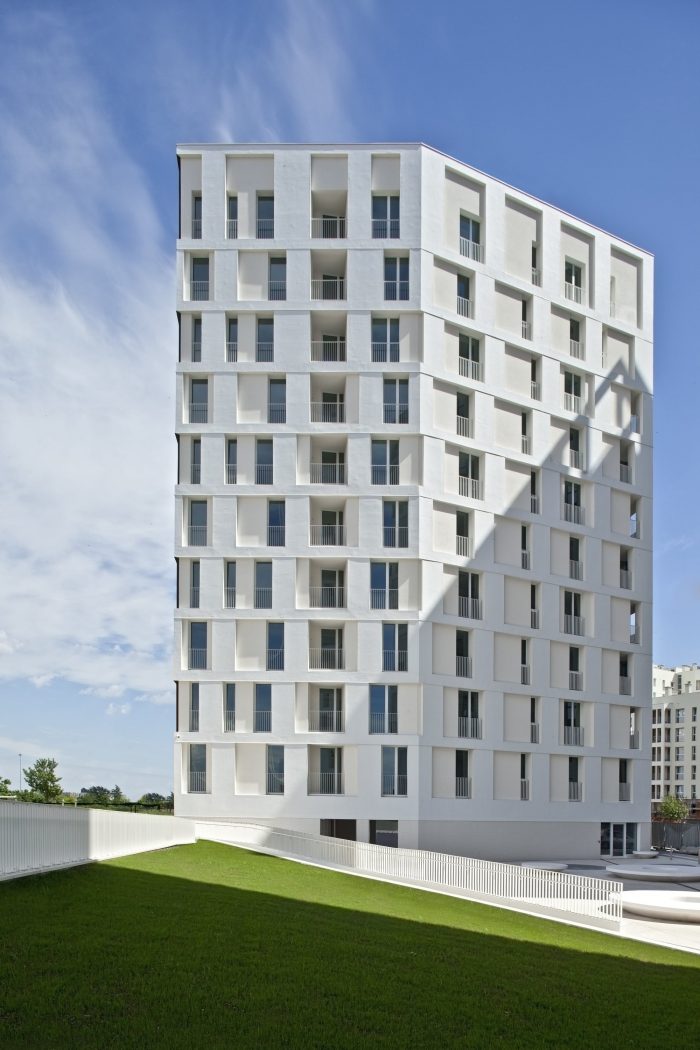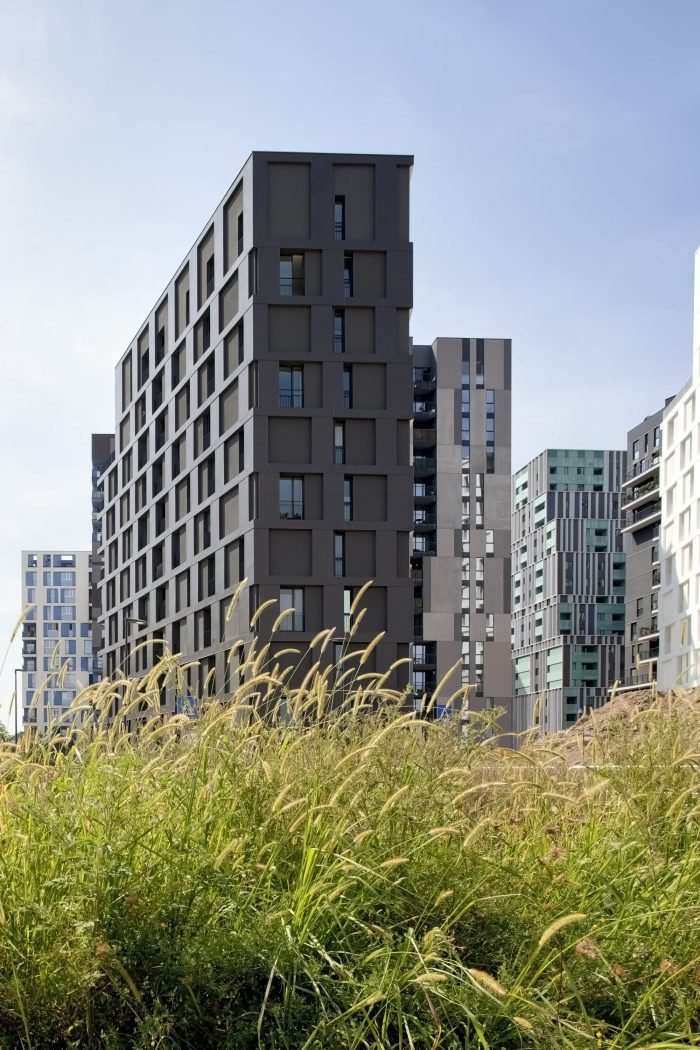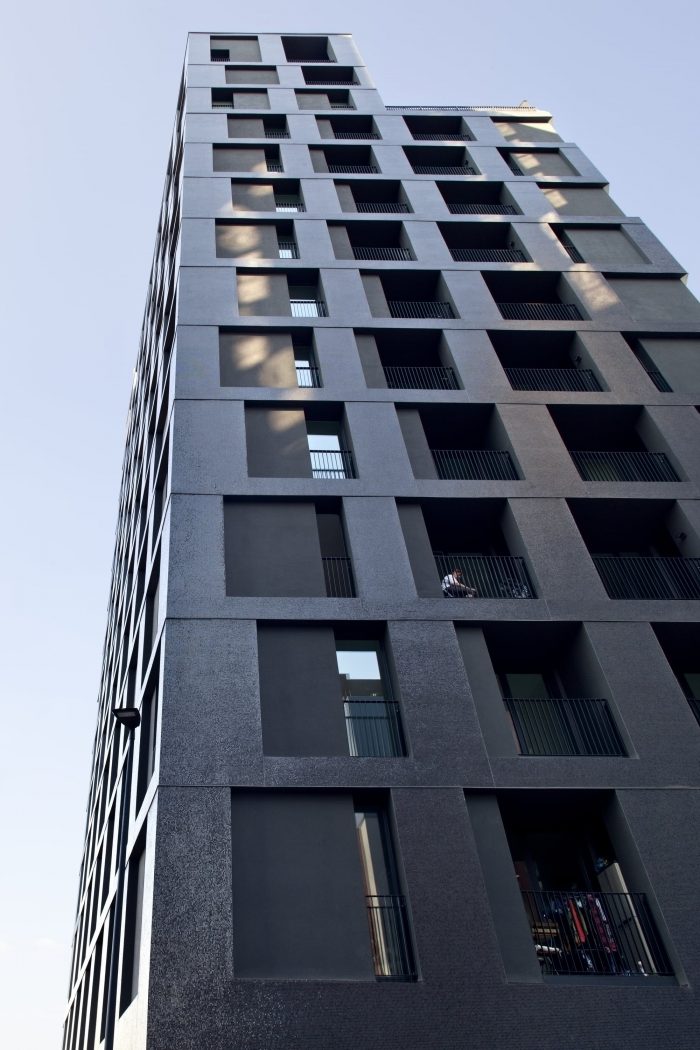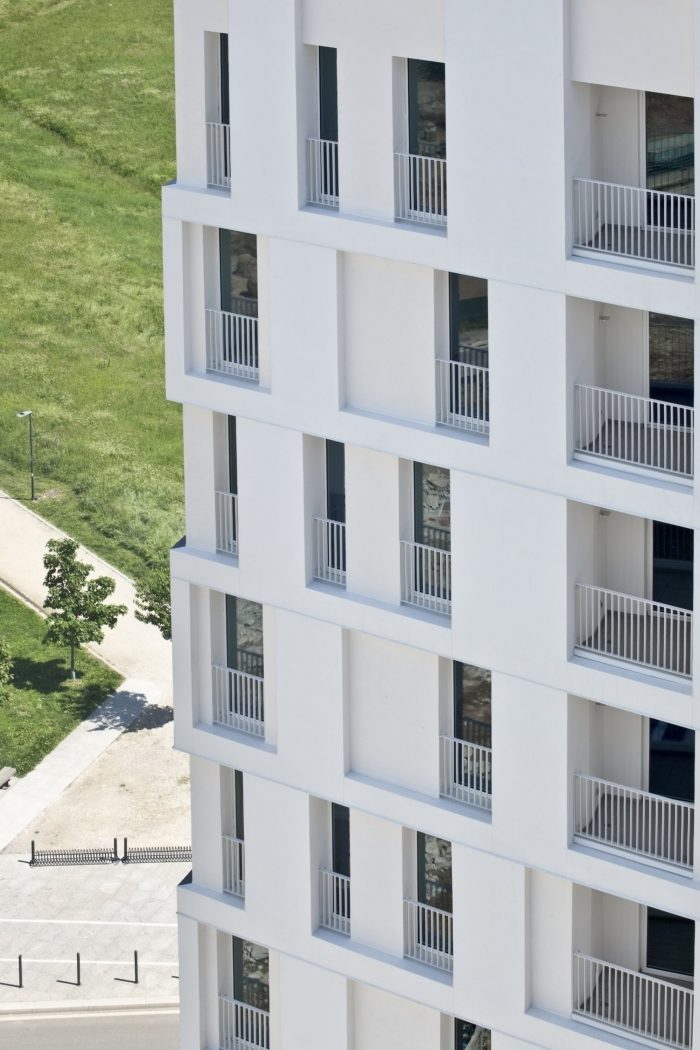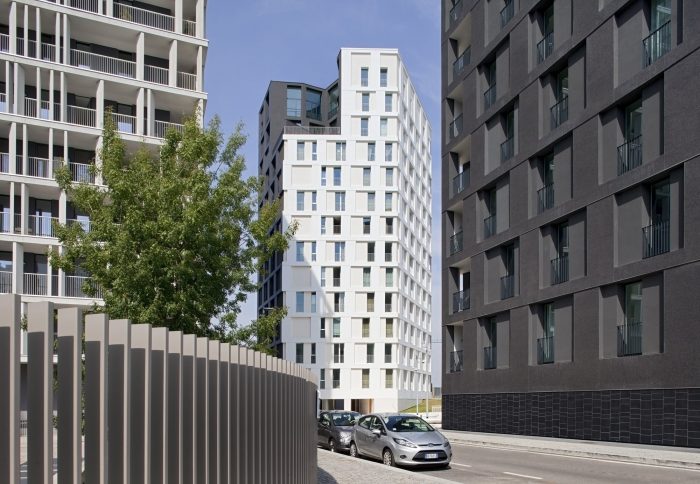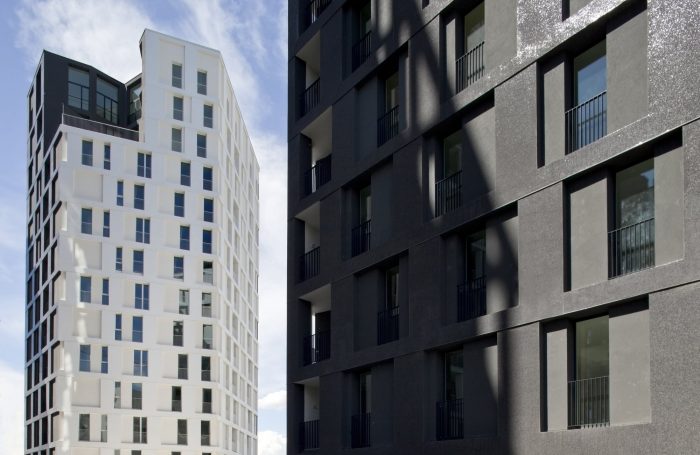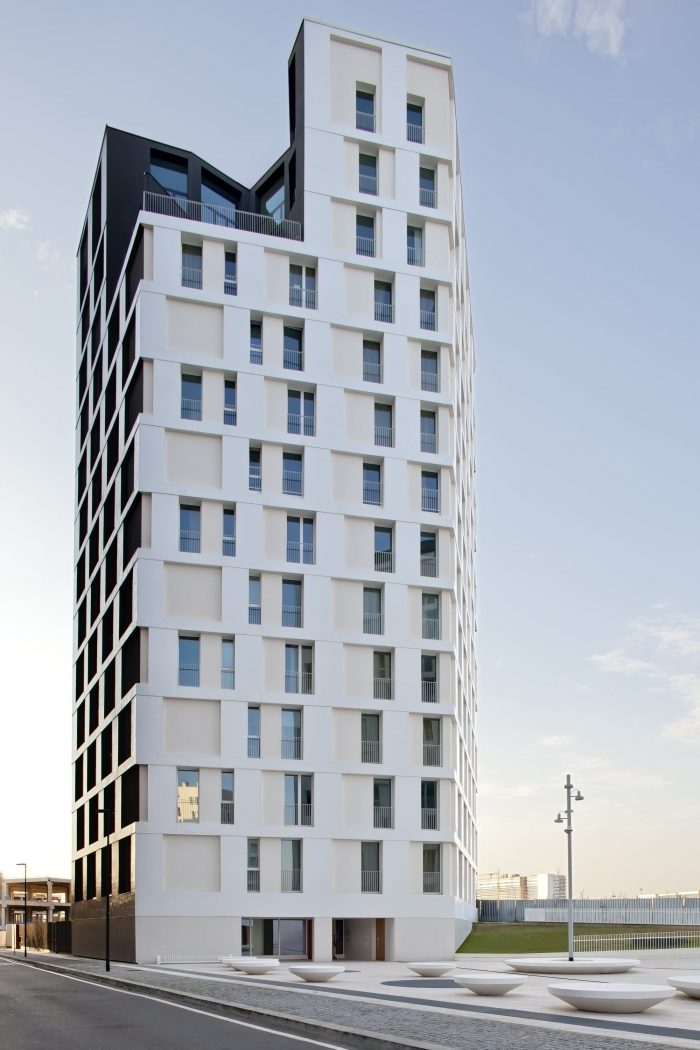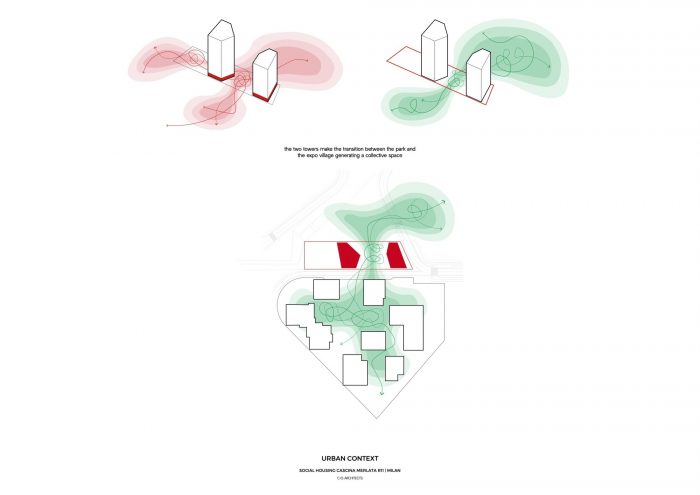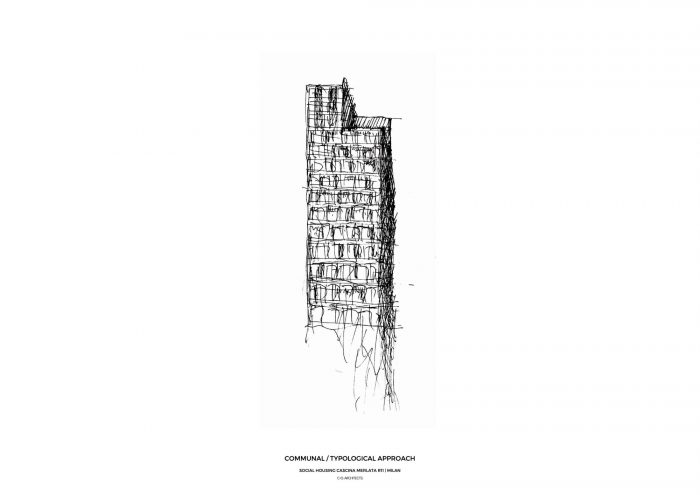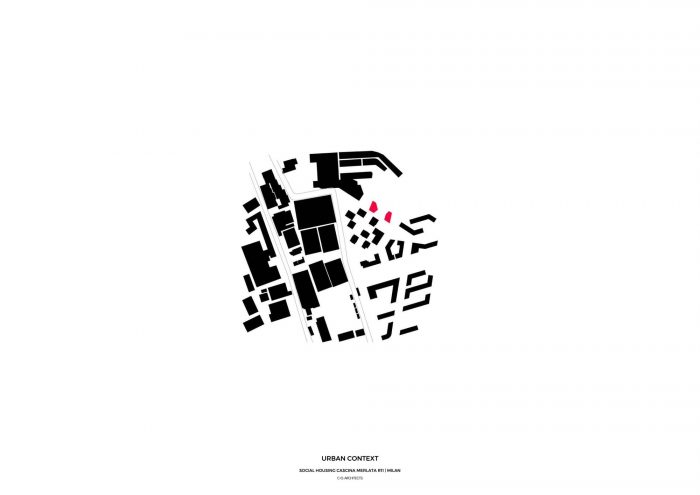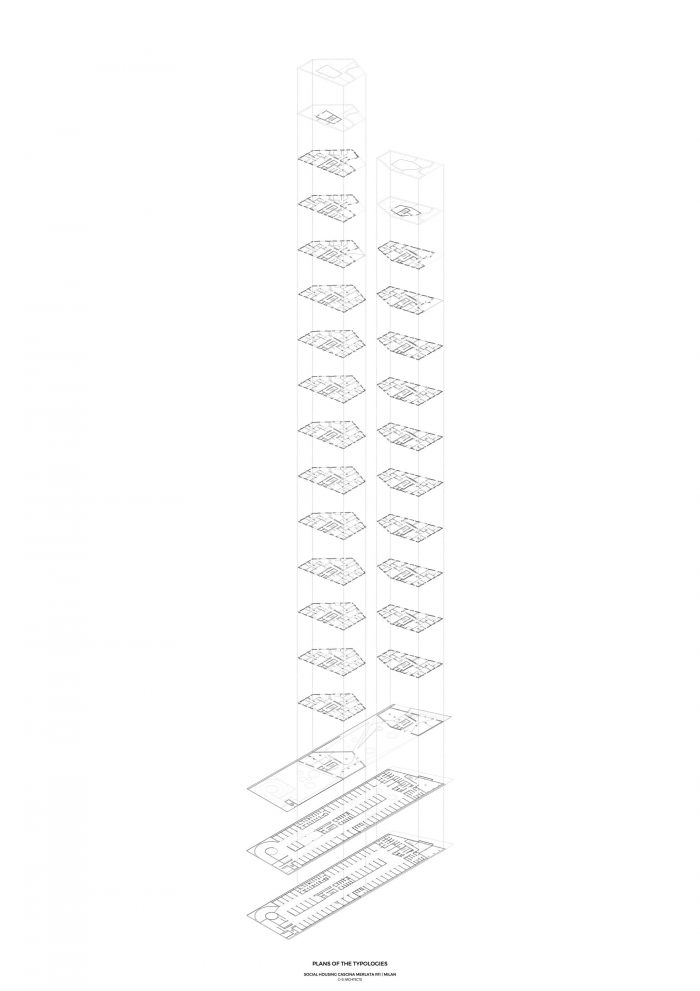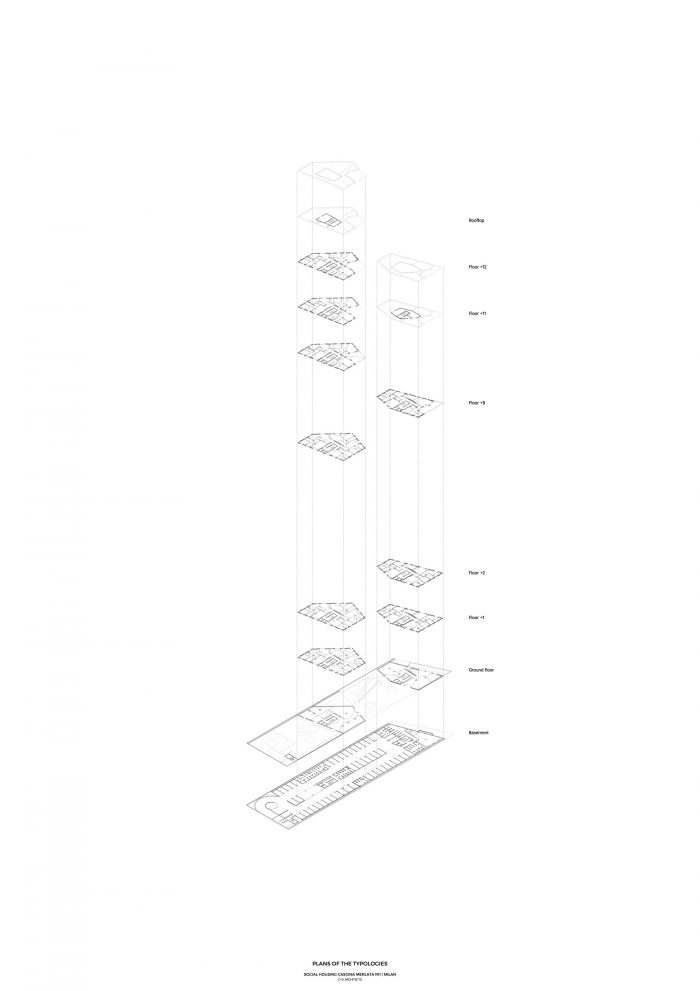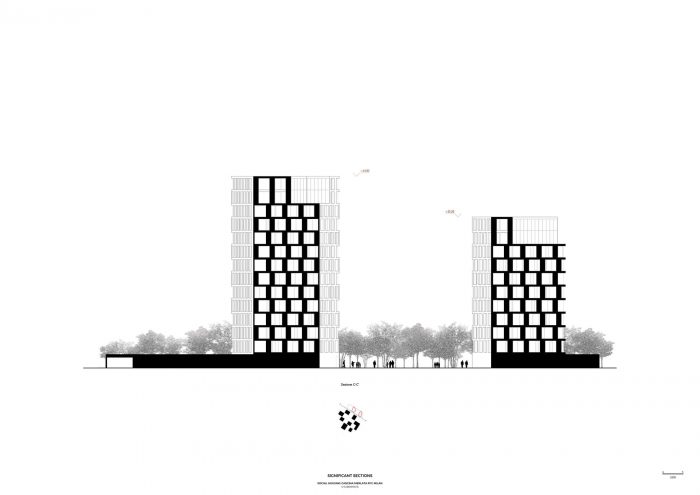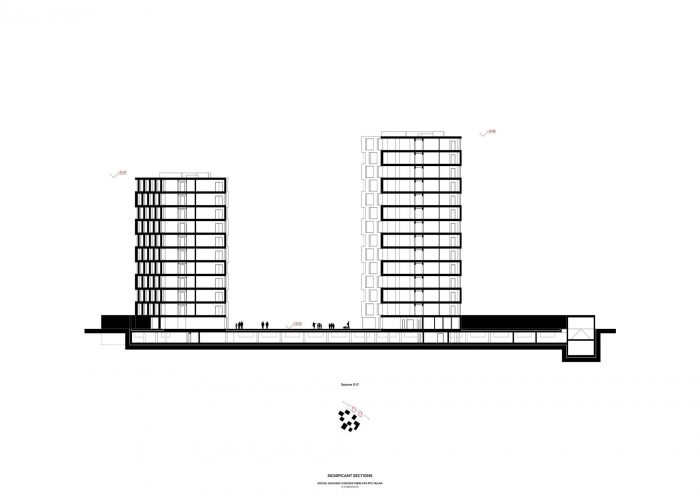R11地块位于高楼村的北端,与欧洲最大的住房开发项目Cascina Merlata公园相邻。最初的规划是一个被栅栏包围的体量,并打算成为一个 “有门的社区”,建筑师建议将该地块分成两部分,以还给社区一个公共空间,并在村子和公园之间创造一个城市之门,后者作为一个公共广场,在地块内延伸。
The plot R11 is located at the northern end of the Highrise Village, bordering the park Cascina Merlata, the largest housing development in Europe. Initially planned as a volume surrounded by a fence and meant to be a ‘gated community, the architects proposed to break the plot into two parts to give back to the community a public space and create an urban door between the Village and the Park, the latter extending as a public square, inside the plot.
一个新的社区空间的想法,借用了 “威尼斯坎普 “的城市概念搬到了米兰,创造了一个广场,一个连接两座住宅楼的公共空间,通过为所有人设计一个场所,加强他们的社区身份。新的广场将不同高度的步行空间和公园联系起来,在建筑和自然之间创造了一个门槛。
The idea of a new community space, borrowing from the urban concept of the “Venetian campo” moved to Milan to create a square, a public space that connects the two residential towers, strengthening their community identity through the design of a place for all people. The new Piazza relates the different heights of the pedestrian space and the park and creates a threshold between the built and natural.
该项目对 “门控社区 “的概念持批评态度。通过给周围的社区提供公共空间,C+S建筑事务所从物理上设计了一个与塔楼在材料和色泽上保持一致的广场,这强调了共享集体空间的重要性,这是加强社区身份的关键点。广场是一个自由、持久、开放的公共空间,所有人(包括视力障碍者)都可以进入,通过一系列的坡道,连接了公园和街道之间约两米的高度差。但它也是一个有趣的公共空间,能够转变为儿童或滑冰者的游乐场,供他们休息和游戏。
The project is critical of the concept of the ‘gated community. By giving public space to the surrounding community, C+S Architects physically design a square in material and chromatic continuity with the towers, which underlines the importance of sharing the collective space as a key point to strengthening the identity of the community. The square is a free, durable, open public space, accessible to all (including the visually impaired) that connects the difference in height of about two meters between the park and the street, through a series of ramps. But it is also a fun public space capable of transforming itself into a playground for children or skaters, for rest and play.
广场由白色Prun石制成,点缀着一系列的圆形长椅,这些长椅的位置是为了防止汽车的侵入。单一材料和单一颜色的空间强调了这个综合体作为公园和城市之间的门槛空间的城市角色。道路和公园之间约两米的高度差,通过5%的倾斜平面设计得以克服。
Made of white Prun stone, the square is dotted with a series of circular benches, which have been positioned to prevent the intrusion of cars. The mono-material and monochromatic space underline the urban role of the complex as a threshold space between the park and the city. A difference in height of about two meters between the road and the park is overcome with the design of 5% sloped planes.
在广场的两侧,两座塔楼(14米和12米高)界定了空间,似乎是由同一个体积产生的,被公共空间一分为二。这两座塔楼开发了10830平方米,分布在103个单位中,根据地区法规,全部作为经济适用房出售。两座塔楼的底层都设有入口大厅和服务空间,如自行车库、公共房间、健身房、洗衣房和分类垃圾收集的储藏室。2011年,C+S项目是在住宅区内插入混合和公共空间时引入ESG驱动的先驱。
On the sides of the square two towers (fourteen and twelve meters high) define the space and seem to have been generated from the same volume, split in two by the public space. The two towers develop 10,830 square meters, distributed in 103 flats, all sold as affordable housing according to the Regional regulations. The ground floor of both towers houses the entrance hall and service spaces, such as bicycle storage, common room, gym, laundry, and storage room for separate waste collection. C+S project was a pioneer, in 2011, in introducing ESG drivers when inserting hybrid and common spaces within the residential complex.
这些塔楼被安排在地下两层,可停放104辆汽车、技术空间和地窖,以及一个丰富多彩的儿童户外游乐场,是与社会住房基金会合作设计的参与性项目。
The towers are arranged on two underground levels of parking for 104 cars, technical spaces, and cellars as well as a colorful outdoor playground for children that was designed with a participatory project in collaboration with the Social Housing Foundation.
总共一百零三套公寓,在施工现场开始后立即全部售出,能源等级为A级,根据成熟的可持续发展战略,在楼层提供地热区域供暖和制冷系统,一个用于控制机械通风和光伏系统,以减少排放和消耗。
The total one hundred and three apartments, all sold in record time immediately after the construction site started, are built in energy class A and provide, according to the well-established sustainability strategies, a geothermal district heating and cooling system on the floor, one for controlled mechanical ventilation and photovoltaic systems, in order to reduce emissions and consumption.
这些塔楼的弯曲、造型和方向,确保所有的公寓都能享受到周围绿色的景色,正面有不同的材料处理:立面,强烈的节奏感,由全高的窗户设计,这些窗户用广场上的白色石头包覆,直到第一层,创造了水平和垂直平面之间的连续性,而在外面,朝向村庄,他们用深色的涂层完成,与相邻的塔楼在色泽上一致。侧面门面的深色有助于强调广场集体空间切口的强度,它被转化为 “通往公园的大门”。
The towers, bent, modeled, and oriented to ensure that all the apartments could enjoy the view of the surrounding green, have a different material treatment on the fronts: the elevations, strongly rhythmic, are designed by full-height windows, which are clad with the same white stone of the square up to the first level, creating a continuity between the horizontal and vertical planes, while on the outside, towards the village, they are finished with a darker coating, chromatically matching the adjacent towers. The darker color of the side fronts helps to underline the strength of the incision of the collective space of the square, which is transformed into the ‘door to the park’.
从二楼开始,塔楼的包层变成了玻璃马赛克,让人想起意大利建筑大师的一些修饰(吉奥-庞蒂的珍贵内饰或莫雷蒂的轻质材料),并意味着这个城市是由珍贵的城市内饰定义的,可以居住。
From the second floor, the cladding of the towers becomes a glass mosaic, recalling some finishing of the masters of Italian Architecture (Gio Ponti’s precious interiors or Moretti’s light textures), and to mean that the city is defined by precious urban interiors to inhabit.
外墙的饰面(超过底层)由绝缘涂层组成,上面粘有1.5×1.5厘米的Sicis型玻璃马赛克。Sicis型玻璃马赛克不是一个平面的涂层。每块瓷砖的截面都是可变的。这种选择使外墙在一天中的每一分钟都能以不同的方式反射光线,从而改变自己。外墙似乎在发光和变化:它被日光的变化和气候的变化所激活。
The finish of the facades (beyond the ground floor) consists of coating insulation, on which the Sicis-type glass mosaic is glued, with 1.5×1.5 cm tesserae. Sicis-type glass mosaic is not a flat coating. Each tile is variable in section. This choice allows the façade to transform itself by reflecting the light in a different way every minute of the day. The façade seems to light up and change: it is activated by the variation of daylight and climatic changes.
立面的构成很简单,有一个规则的网状结构,在上面绘制了一系列有区别的分层的深度。主要的模式是由一个大型方形开口的网格决定的,该网格定义了木屋的大小。因此,纹理的特点是不规则地交替出现的木屋、窗户和覆盖着与马赛克一致的颜色的盲道部分。每种材料的选择也是因为其耐用性和可回收性,随着时间的推移。
The composition of the façade is simple and has a regular mesh on which a series of differentiated stratifications are drawn in depth. The main pattern is determined by the regular design of a grid of large square openings that defines the size of the loggias. The texture is thus characterized by the irregular alternation of loggias, windows, and blind parts covered with colors in accordance with the mosaic. Each material was also chosen for its durability and recyclability over time.
随着两座R11塔楼和广场的完成,C+S建筑事务所正式进入了那个当代实验室,在过去的十年里,这个实验室已经成为米兰市,同时与他们自己的研究保持一致。
With the completion of the two R11 towers and the square, C+S Architects officially enter that contemporary laboratory, that has become the city of Milan in the last decade while remaining consistent with their own research.
Architects: C+S Architects
Area : 10850 m²
Year : 2022
Photographs :Alessandra Bello and Pietro Savorelli
Manufacturers : Sicis
Lead Architects : Carlo Cappai, Maria Alessandra Segantini
Structures : SCE Project Srl
MEP Engineering : Ariatta Ingegneria dei sistemi srl
Team : Mara Mior, Davide Testi
Client : Investire sgr, EuroMilano s.p.a.
City : Milan
Country : Italy

